- Share
Parental Proximity and the Earnings Consequences of Job Loss
We find post-job-loss earnings recovery is faster for young adults who live near their parents than for young adults who live farther away. This positive effect diminishes gradually as the distance to one’s parents increases. Most of the effect is driven by higher wages after job displacement, not by differences in the number of hours worked. The effect is not present for older workers, who may be caring for elderly parents.
The views authors express in Economic Commentary are theirs and not necessarily those of the Federal Reserve Bank of Cleveland or the Board of Governors of the Federal Reserve System. The series editor is Tasia Hane. This paper and its data are subject to revision; please visit clevelandfed.org for updates.
Losing a job can have negative, long-lasting effects on a person’s future earnings. One thing that might significantly improve this adverse outcome is having a parent who lives nearby and who is able to help during this time of transition. Parents could provide a place to sleep, job search assistance, and mentoring, all of which could lessen the economic turbulence typically associated with job loss.
We study the importance of parental proximity by comparing the post-job-loss earnings of adults who live near their parents (within the same Census tract or commuting zone) at the time they lose their jobs to the earnings of those whose parents don’t live nearby. We find evidence that is consistent with parental resources being important. Young adults (ages 25 to 35) who live in the same neighborhoods as their parents earn roughly the same amount five years after a job loss as a control group of people who did not lose their jobs. In contrast, those living farther from their parents experience a large decline in earnings that persists 10 years after displacement.
For older adults (ages 36 to 55), we see no difference in post-displacement earnings outcomes between people who live close to their parents and those who live far away from their parents. This may be because some older adults live close to their parents in order to take care of them.
Our study does not prove that parental resources are responsible for the better earnings outcomes of some adults who lose their jobs; it only shows that the two are correlated. However, our work is a necessary first step. By finding a correlation between parental proximity and postdisplacement earnings, we demonstrate the question is worth a more sophisticated analysis.
Data and Sample Construction
We use annual data from the Panel Study of Income Dynamics (PSID) covering 1968 to 2013. We include observations on individuals between the ages of 18 and 62, restricting our attention to what the PSID refers to as “household heads.”1 These annual survey data include repeated observations of individuals’ demographic information and their labor earnings in the previous calendar year,2 job histories, and parental location.
Using this information, we define displaced workers as individuals who lose relatively stable jobs through no fault of their own (e.g., plant closings). We impose that workers had at least two years with their employer and were working full-time before the job displacement event so that our sample of workers has a strong connection to the labor market. We use the earnings and parental location information from the survey to compare the earnings outcomes of displaced workers to the earnings outcomes of nondisplaced workers and to study how these outcomes differ for individuals who live close to and those who live farther from their parents.
Our data set consists of around 35,000 people, with an average of 20 years of observations for each person. The data contain about 1,350 job displacement events, of which approximately 450 took place while an individual resided in their parents’ neighborhood, and approximately 900 occurred while an individual was not in their parents’ neighborhood.3 Summary statistics from the data reveal the following:
- Displaced workers are slightly younger, are less educated, and have been with their employer for a shorter period of time than their nondisplaced counterparts.
- Displaced workers earn significantly less than nondisplaced workers, even before the displacement event.
- Those who live outside of their parents’ neighborhoods tend to be younger, be more educated, and earn significantly more than those who live in their parents’ neighborhoods.
- Around 30 percent of adults live in the same neighborhoods as their parents.
Preliminary Results
Figure 1 plots average earnings before and after a displacement. Panel A presents the average earnings of displaced and nondisplaced workers ages 25 to 35. The figure highlights the dramatic earnings consequences of displacement:
- On average, displacement leads to a large initial decrease in annual earnings of around $10,000, which is about 20 percent to 25 percent of predisplacement earnings.
- While earnings for these displaced individuals recover, this recovery does not exceed the earnings gains experienced by nondisplaced workers. In fact, displaced workers’ earnings recover to their predisplacement level about six years after the displacement event, but displaced workers’ earnings do not catch up to those of nondisplaced workers even 10 years after displacement.
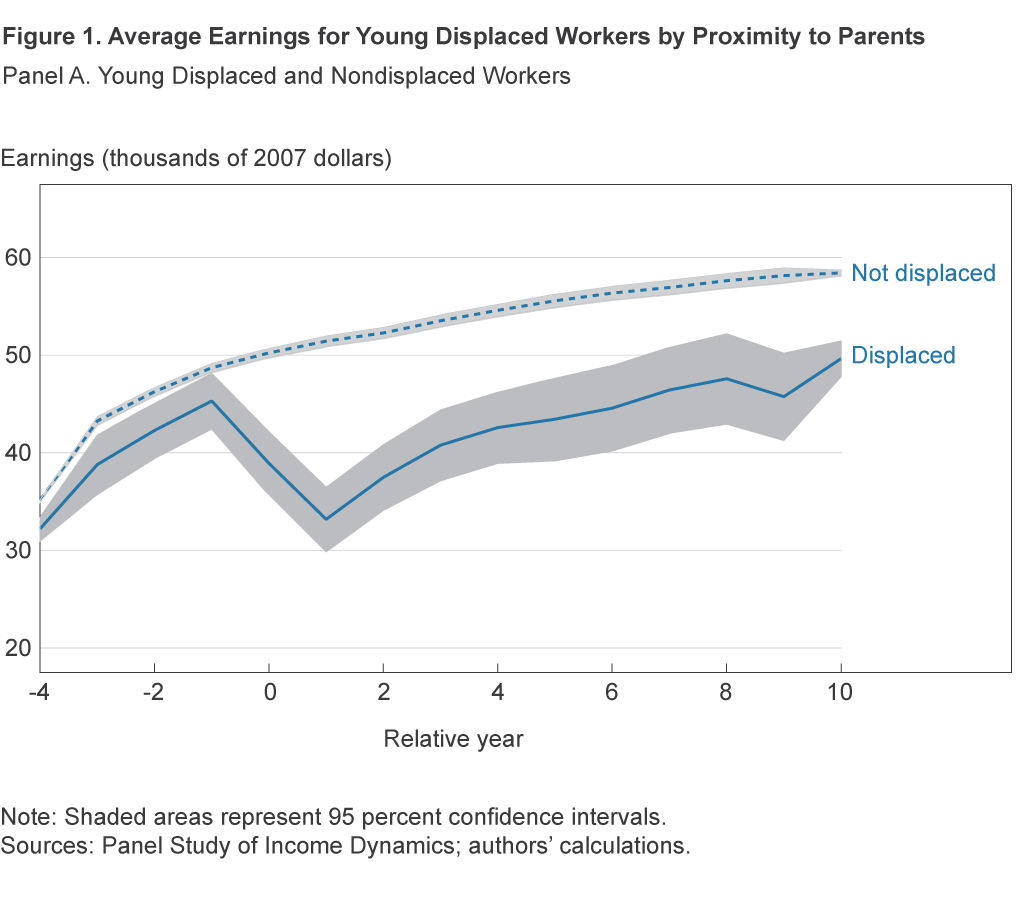
Panel B decomposes average earnings into those of displaced workers who were in their parents’ neighborhoods in the year prior to displacement and those who were not.4 The figure shows that proximity to parents is correlated with future earnings. Displaced workers not in the same neighborhoods as their parents see large earnings losses relative to those who were not displaced. This earnings gap persists over the following 10 years. In contrast, displaced workers who were in the same neighborhoods as their parents in the year prior to the displacement event see a much healthier earnings recovery. Panel B shows that the earnings of displaced workers who live near their parents recover to their nondisplaced counterparts within six years of the displacement event; this means that displaced workers who don’t live near their parents shoulder all the burden of the long-run negative effects of displacement on earnings.5
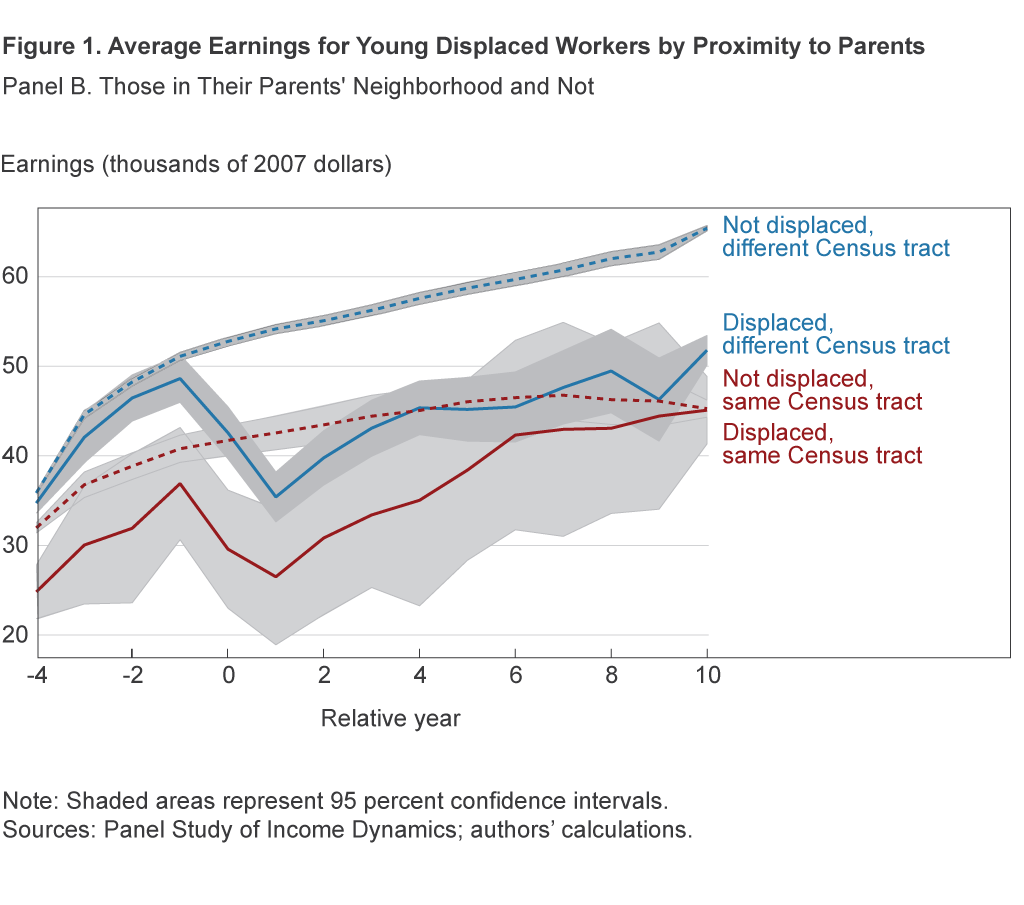
Controlling for Systematic Differences between Groups
It is possible that systematic, observable differences, such as age or education level, exist between workers who are displaced and nondisplaced or workers who live in their parents’ neighborhood and those who live farther away. There may also be differences between these groups that are unobservable, such as motivation and ability. The averages presented in figure 1 do not control for these possible differences. To address this concern, we conduct a regression analysis.
This analysis allows average earnings to evolve differently for displaced and nondisplaced workers who reside close to and farther from their parents. The analysis controls for differences between these individuals that do not change over time, including observable characteristics such as gender, race, ethnicity, and education, as well as for unobservable characteristics. The econometric framework allows average earnings to vary by calendar year since, for workers, some years are better than others. The approach, however, does not consider that other factors, correlated with living in the same neighborhood as one’s parents, may explain the differential impact of displacement on earnings. For example, if individuals with low earnings tend to see a faster earnings recovery postdisplacement, and those living in the same neighborhood as their parents tend to have lower earnings, the following analysis will attribute the faster earnings recovery of those living in the same neighborhood as their parents to parental location.
Figure 2 presents the regression results. These tell the same story as the simple averages presented in figure 1. At the time of displacement, workers experience large declines in earnings; losses are around $10,000 for those living in their parents’ neighborhoods and around $15,000 for those living farther away. With average predisplacement earnings of these groups being around $35,000 and $50,000, respectively, the decline in both cases represents a 30 percent decline in earnings at the time of displacement. The postdisplacement recovery, however, is quite different for the two groups. The group living farther from their parents experiences a small recovery in the first few years following displacement but still has earnings losses of around 30 percent relative to nondisplaced individuals 10 years after the displacement event. In contrast, the group that was living in the same neighborhood as their parents prior to the displacement event experiences a steady recovery after displacement, and, after five years, their earnings are indistinguishable from those of the group that was not displaced.6
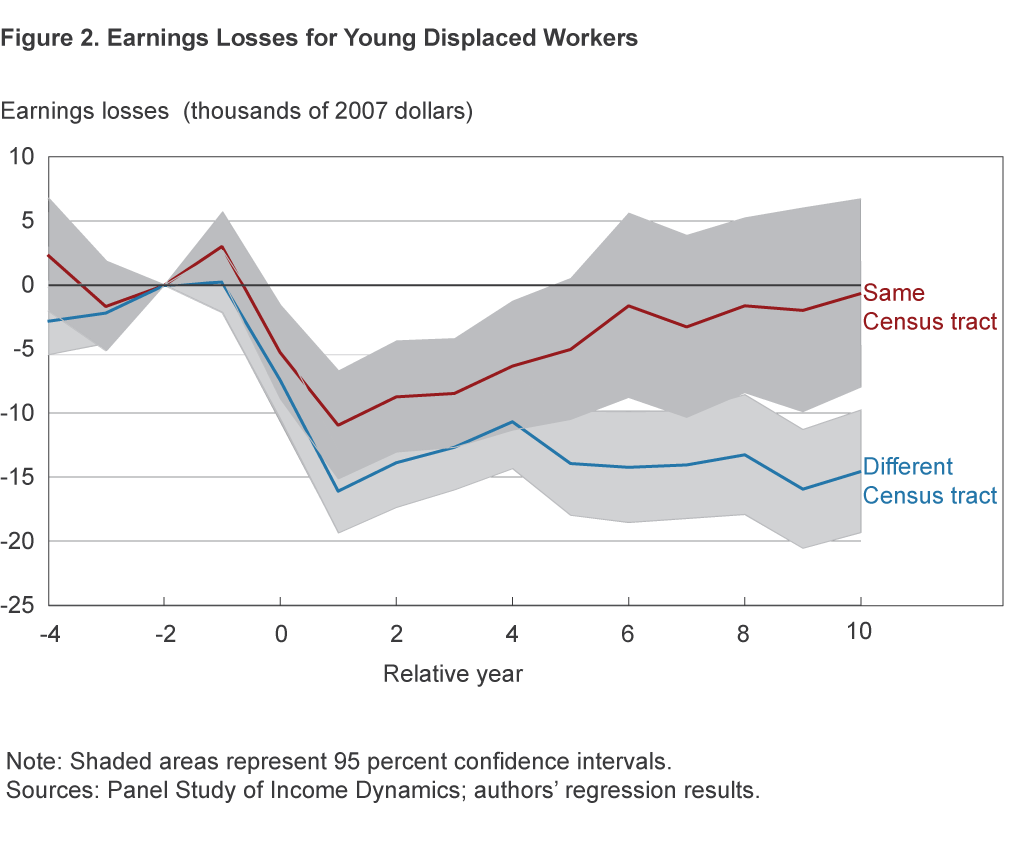
Employment, Hours, and Wages
The better earnings outcomes of displaced workers who live close to their parents could be the result of a number of factors. Those displaced while living close to their parents could (a) experience higher employment rates after the displacement event than displaced workers who lived farther from their parents, (b) work longer hours or more weeks, conditional on employment, or (c) receive higher remuneration per hour. Further analysis of the regression results shows that higher compensation is the operative factor: Those who were displaced when living close to their parents work for better pay, but their working hours are comparable to those who did not live in their parents’ neighborhood, and they are no more likely to be employed than displaced workers who lived farther from their parents.
Figure 3 presents the regression results with three different outcomes: employment status at the time of the interview, hours worked during the last calendar year (conditional on having worked last year), and earnings per hour. Panel A shows that the probability of being employed falls dramatically after the displacement event and remains depressed, but this effect is similar for both those living in their parents’ neighborhoods and those living farther away.
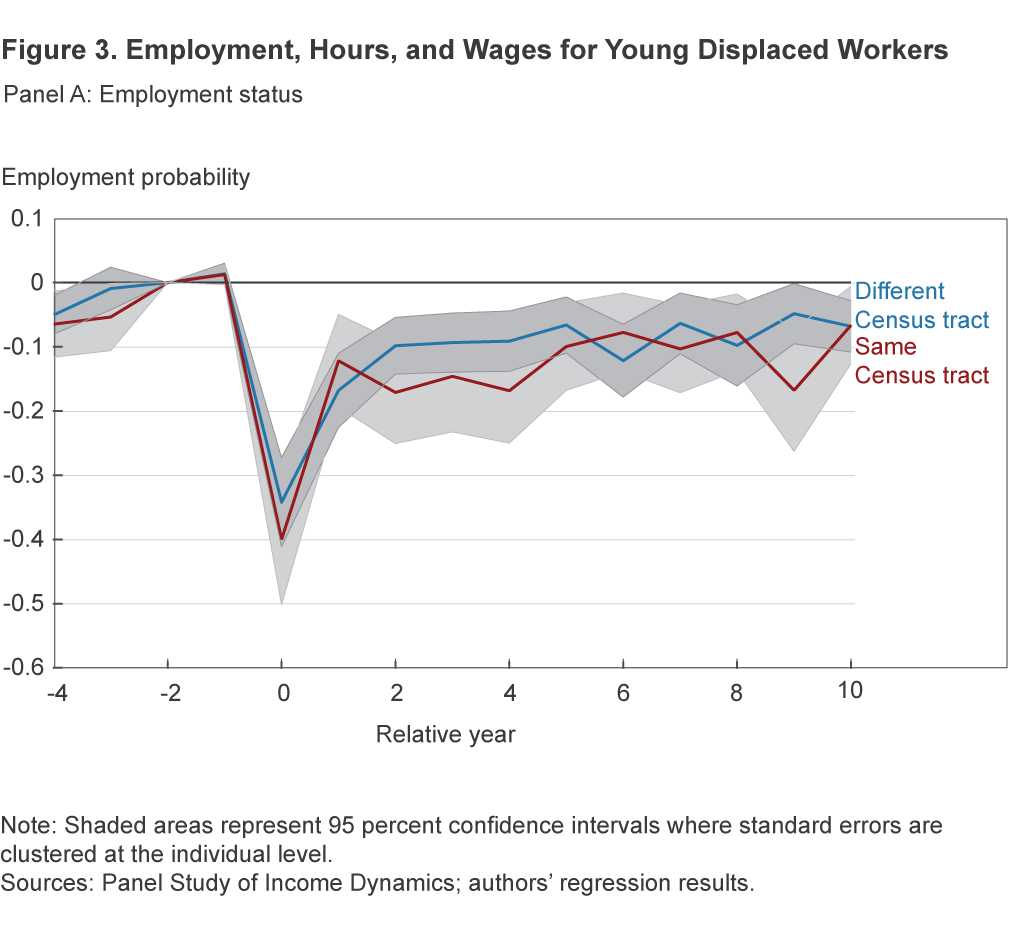
Panel B of figure 3 shows that there seem to be no meaningful differences in the hours’ recovery (conditional on being employed) between those living close to and those living farther from their parents. At the time of displacement, both groups experience a reduction of about 400 hours in the number of hours they work (around 15 percent of the 2,000 hours prior to displacement). This reduction is followed by a sharp rise in hours worked in the three years following the displacement event, and no significant improvement in hours worked thereafter.
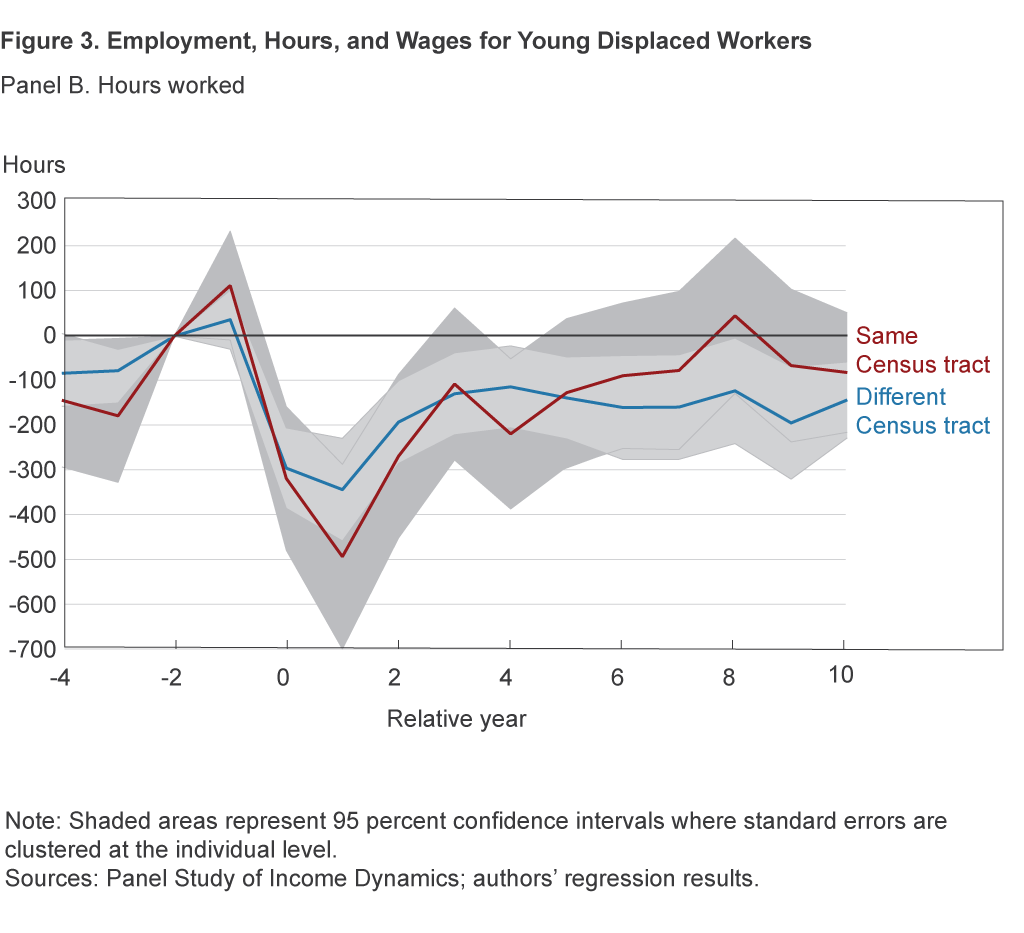
Panel C of figure 3 shows that hourly earnings resemble the earnings results in figure 2; those living close to their parents have smaller wage reductions and see a complete recovery within six years of displacement, and those living farther from their parents see large and permanent wage reductions.
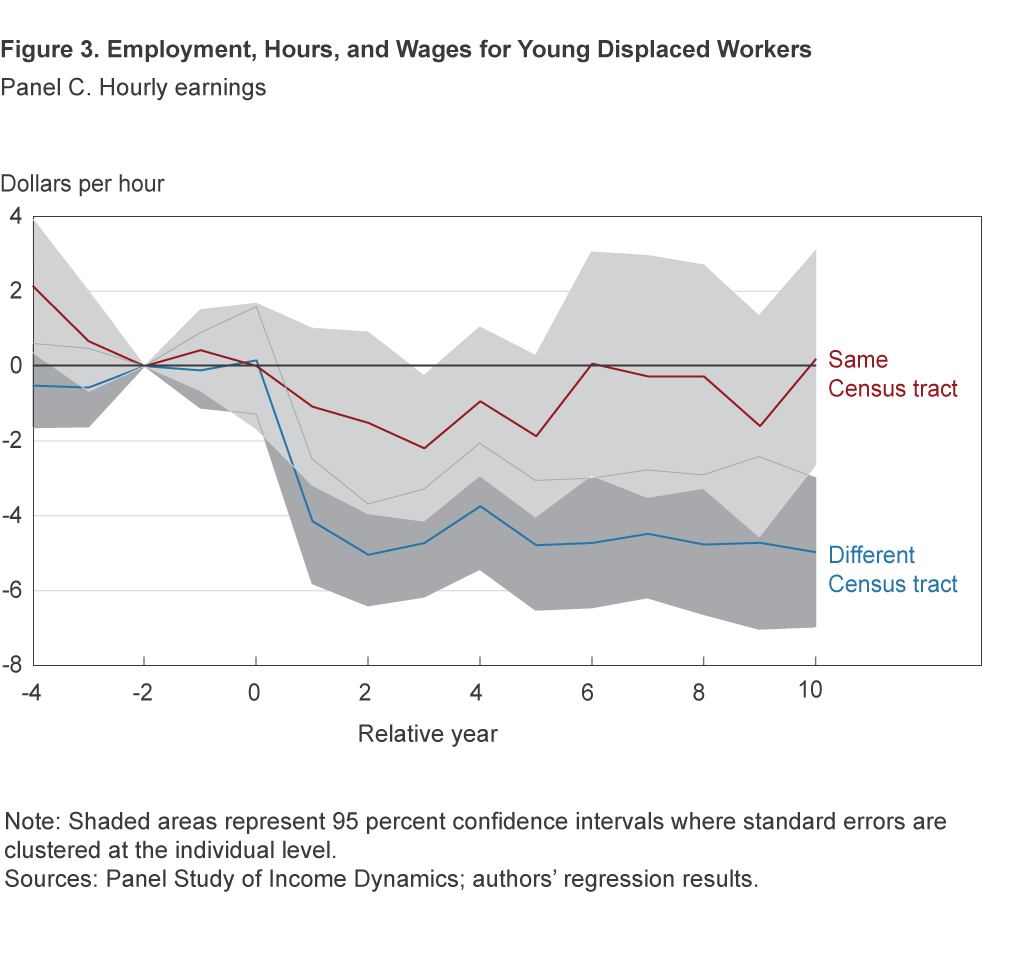
The Impact of Age and Distance on the Earnings Results
This analysis suggests that young workers living in their parents’ neighborhoods prior to job displacement experience stronger labor market recoveries than those who live farther from their parents. We can think of three major mechanisms that would be consistent with these results:
- Parents may provide informal insurance during adverse labor market shocks, stepping in with resources such as housing, child care, and food when their adult children experience job losses, assistance which could facilitate a more ambitious job search (Kaplan, 2012).
- Parents may use their social networks to assist their adult children in finding employment after their job losses (Kramarz and Skans, 2011).
- Parents may provide additional motivation and encouragement to their children after the job displacement, a situation which may help with the job search process (Dalton, 2013).
Although we leave the work of disentangling the role of these three channels to future research, we think that all three effects should diminish as the age of the adult child and the geographic distance between the child and his or her parents increases. For example, as adult children grow older (and their parents age), living close to parents may be a sign that the parents need assistance, implying that the transfer of resources begins to flow from adult child to parent. Similarly, although it may be easier to provide in-kind assistance when children are close to parents geographically, this gets harder the farther away the children live. This section shows that the data support these hypotheses.
Figure 4 shows the earnings trajectories for young (ages 25 to 35) displaced workers who were living very close to their parents (the same neighborhood), close to their parents (the same commuting zone but not the same neighborhood), and farther away from their parents (outside of the commuting zone).7 The figure suggests that those living within the same commuting zone but not the same Census tract as their parents also experience significantly better postdisplacement earnings outcomes than those who live outside of their parents’ commuting zones. This suggests that the positive effect of one’s parents’ presence dissipates gradually with distance, not sharply at the border of a neighborhood.
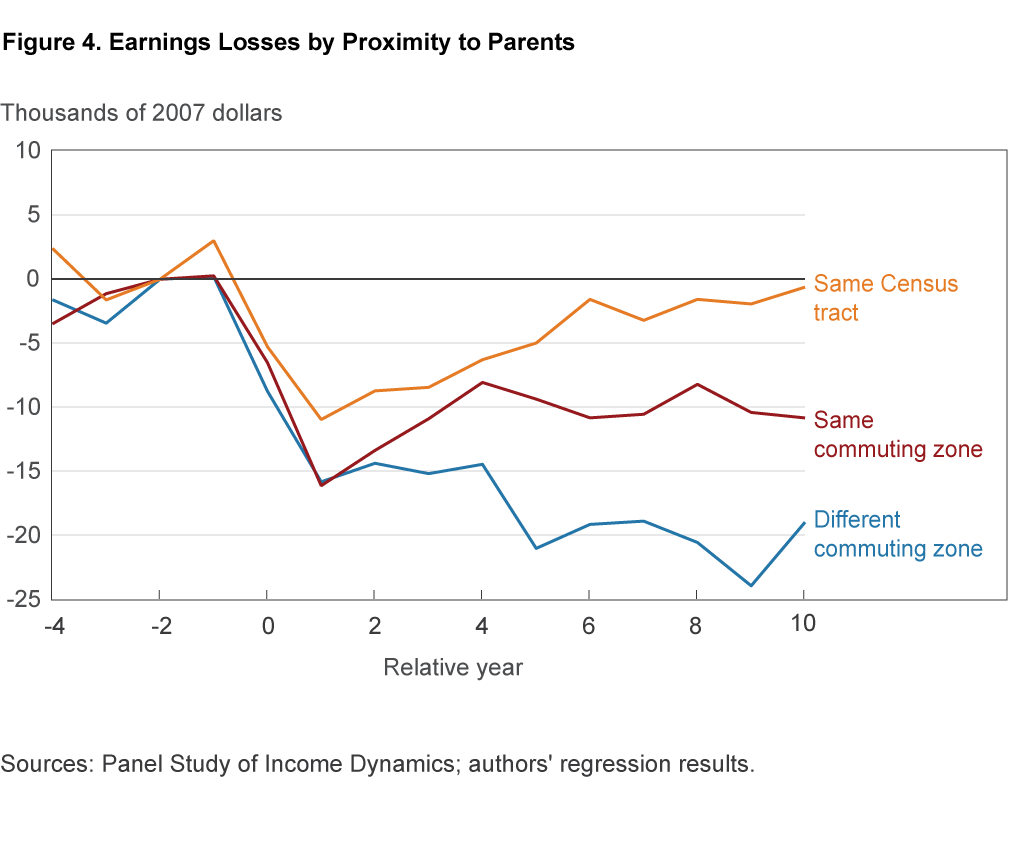
Figure 5 shows the earnings trajectories for older workers ages 36 to 55, some of whom were living in their parents’ neighborhoods and some of whom were living farther away prior to displacement. This figure suggests that, for older workers, living in their parents’ neighborhoods does not help postdisplacement labor outcomes in the same way that it assists younger workers (those 25 to 35). We find this result intuitive, as older workers are more likely to be living close to their parents because their parents need them, not the other way around.
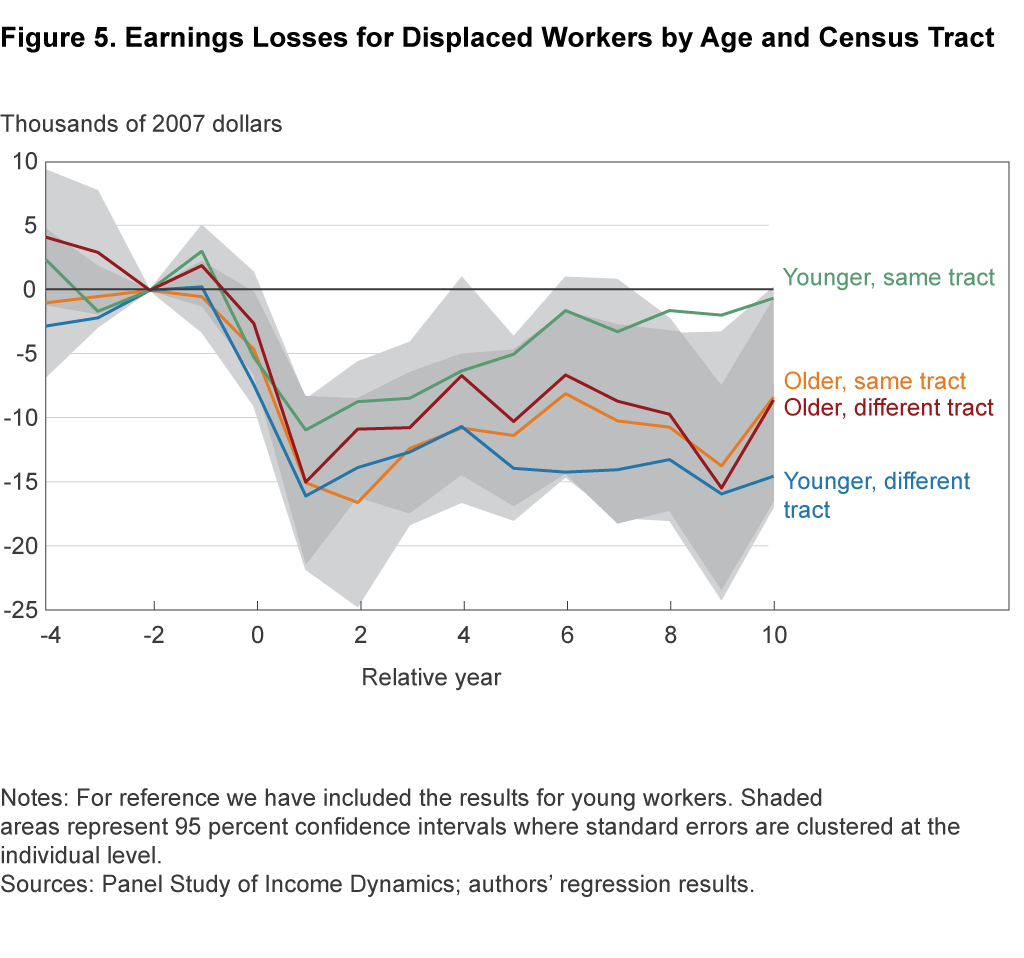
Policy Implications
This analysis shows that young individuals residing close to their parents experience smaller earnings declines following job displacement than individuals in the same age range who reside farther from their parents. Although this correlation does not demonstrate causality, our findings suggest that parents play an important role in adult children’s labor market outcomes and that family connections are, therefore, potentially important for the labor market decisions of adult children. In particular, the analysis in this Commentary suggests that family presence may impact workers’ migration decisions and possibly explain their sometimes surprising reluctance to move, especially among those who are less educated (Bound and Holzer, 2000). Understanding the impact of family connections on children’s labor market outcomes can also inform governmental assistance programs after job losses.
If further research shows more definitively that being close to one’s parents is particularly valuable after a job loss, it could help explain people’s reluctance to relocate for new jobs. It would also suggest that localized recessions might be longer and more pronounced than economists might have otherwise thought. This benefit to living near one’s parents after a job loss would also help explain why workers appear to be less mobile in economic downturns (Saks and Wozniak, 2011) and why immigrants appear to be much more mobile than natives (Cadena and Kovak, 2016). More directly, the resources provided by family after a job loss may help explain the finding that workers place a premium on living close to their birthplaces (Kennan and Walker, 2011; Coate, 2014).
Finally, our findings could help inform how local governments might structure assistance programs after job losses. If governments would like workers to relocate after job losses, they might wish to establish programs to support workers in similar ways as workers’ families already do. Even if these programs perfectly crowd out family investments, they may still be worthwhile in allowing workers to relocate across geographies. Further research regarding family assistance after job loss may also illuminate the specific mechanisms that allow families to support workers after they lose their jobs. Governmental programs may be able to replicate some of these mechanisms.
Footnotes
- This is defined as the person who is at least 16 years old and has the most financial responsibility for the family unit. The PSID virtually always defines this person as the male in a husband–wife pair or if the woman has been living with a boyfriend for at least one year. Return to 1
- We convert all earnings values to 2007 dollars. Return to 2
- We use Census tracts as a measure of neighborhoods (see https://www.census.gov/geo/reference/gtc/gtc_ct.html). Return to 3
- Because of the genealogical nature of the PSID data, we typically observe the parents of single adults or one set of parents of a married couple. We treat cases in which we have the location of the husband’s or wife’s parents symmetrically, although sometimes this means we are using the household head’s parents and sometimes the household head’s parents-in-law. In some cases, we will observe multiple parents’ locations (typically due to the divorce of an original PSID household head); in these cases, an adult child is coded as “same neighborhood” if that child lives in the same Census tract as any parent or in-law. Return to 4
- The results are similar when we look at individuals who are actually coresiding with their parents as opposed to living in the same neighborhoods as their parents. Return to 5
- The results are similar if one drops observations that have zero annual earnings. Return to 6
- Tolbert and Sizer (1996) provide an overview of the design of commuting zones, which are meant to capture the places where people both live and work. The 722 commuting zones in the continental United States (741 including Alaska and Hawaii) are similar in design to metropolitan statistical areas, but they also cover rural areas. Defining geographies based on commuting patterns should help ensure that someone who is listed as “close” to a parent is within a distance that a worker would be willing to travel routinely. Census tracts are contained within commuting zones. Return to 7
References
- Bound, John, and Harry Holzer, 2000. “Demand Shifts, Population Adjustments, and Labor Market Outcomes during the 1980s,” Journal of Labor Economics, 18(1): 20–54.
- Cadena, Brian C., and Brian K. Kovak, 2016. “Immigrants Equilibrate Local Labor Markets: Evidence from the Great Recession,” American Economic Journal: Applied Economics, 8(1): 257–290.
- Coate, Patrick, 2014. “Parental Influence on Labor Market Outcomes of Young Workers,” unpublished manuscript. Available at https://sites.google.com/site/patrickecoate/research.
- Dalton, Michael, 2013. “Family Transfers in Response to Unemployment,” unpublished manuscript.
- Kaplan, Greg, 2012. “Moving Back Home: Insurance against Labor Market Risk,” Journal of Political Economy, 120(3): 446–512.
- Kennan, John, and James R. Walker, 2011. “The Effect of Expected Income on Individual Migration Decisions,” Econometrica, 79(1): 211–251.
- Kramarz, Francis, and Oskar Nordström Skans, 2014. “When Strong Ties Are Strong: Family Networks and Youth Labor Market Entry,” Review of Economics Studies, 81(3), 1164–1200.
- Saks, Raven E., and Abigail Wozniak, 2011. “Labor Reallocation over the Business Cycle: New Evidence from Internal Migration,” Journal of Labor Economics, 29(4): 697–739.
- Tolbert, Charles M., and Molly Sizer, 1996. “U.S. Commuting Zones and Labor Market Areas: A 1990 Update,” ERS Staff Paper #9614.
Suggested Citation
Coate, Patrick, Pawel M. Krolikowski, and Mike Zabek. 2017. “Parental Proximity and the Earnings Consequences of Job Loss.” Federal Reserve Bank of Cleveland, Economic Commentary 2017-03. https://doi.org/10.26509/frbc-ec-201703
This work by Federal Reserve Bank of Cleveland is licensed under Creative Commons Attribution-NonCommercial 4.0 International





